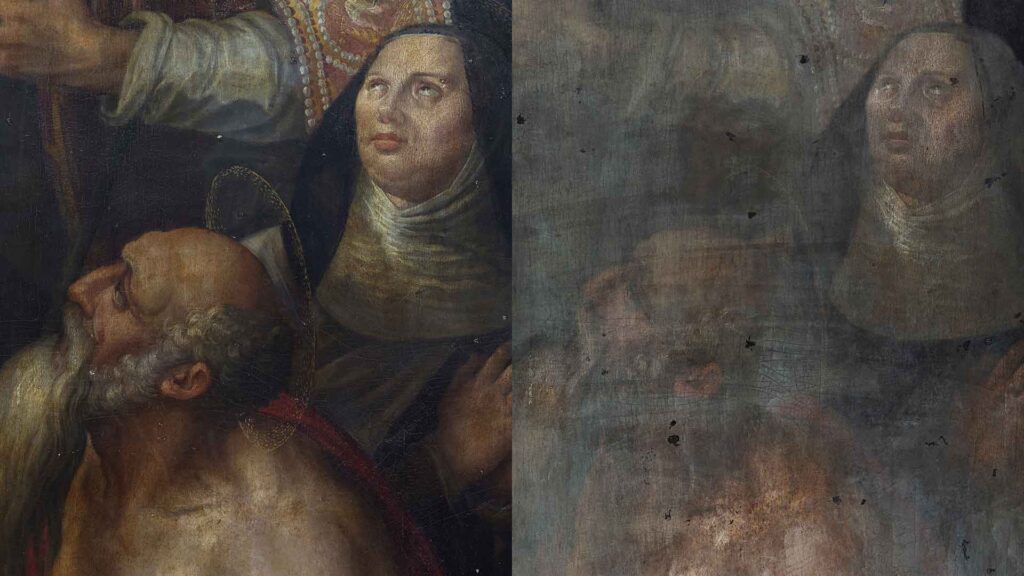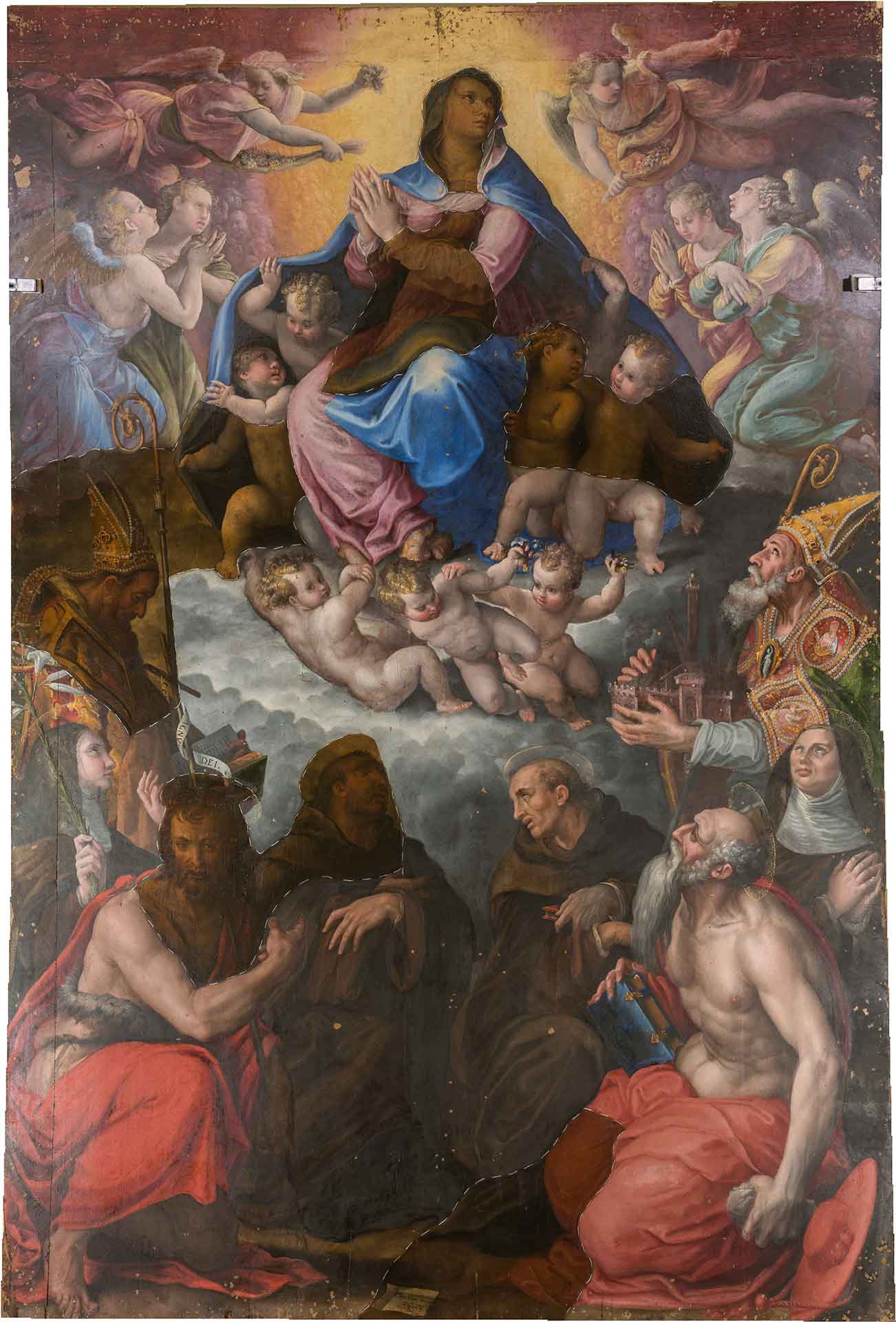Assunzione della Vergine e Santi
Technical Details
-
Title
Assunzione della Vergine e Santi -
Author
Prospero Fontana -
Year
1570 -
Room
XVIII
Prospero Fontana (Bologna 1509 – 1597), a prolific and influential protagonist of the Bolognese art scene up to and beyond the beginnings of the Carracci, in his long career can be said to have traversed all phases of the history of Mannerism, from the Tuscan-Roman affirmation of the 1940s to the sunset of the 1980s.
A pupil, as is well known, of Innocenzo da Imola, then in Genoa at the side of Perin del Vaga until 1539, active in Rome between 1544 and 1547 for the commission of Pope Julius III del Monte, he was a close associate of Giorgio Vasari, lived and welcomed the Catholic Counter-Reformation in his later production, was in his city a point of reference for some of the most illustrious protagonists of Felsine culture such as Ulisse Aldovrandi and Achille Bocchi, and Cardinal Gabriele Paleotti turned to him for a technical opinion on the role of the ‘artist in view of the writing of the famous Discorso intorno alle immagini sacre e profane of 1582.

The Assumed Virgin and Saints Augustine, Clare, John the Baptist, Francis, Anthony, Jerome, Petronius, and Monica was painted Fontana in 1570 for the church of Nostra Signora delle Grazie in Bologna. The painting remained on display on the high altar until Napoleonic requisitions, and came to the Pinacoteca di Brera in 1811. The great panel’s journey, however, did not end with its arrival at Brera: long granted in deposit to three different Milanese churches, it was only between 1901 and 1943 that it was exhibited in the Bologna section of the Pinacoteca, a period in which it also faced tumultuous moves to shelters during the world wars, before returning in 1991 to the Pinacoteca’s storage rooms, in a state of preservation that prevented its display.

Restoration of the painting was carried out in the Pinacoteca Brera’s restoration laboratory between 2020 and 2023. The large altarpiece, 357 cm high by 240 cm wide, was severely obscured by ancient repainting and oxidized varnishes (fig. 1); it also suffered from the instability of the wooden support, which in the course of its troubled conservation history lost one of its supporting crossbeams and suffered deformations and cracks.

Painting technique
The wooden board consists of seven vertical poplar planks to which a 14-cm-high band is added at the top, also made up of seven vertically placed poplar planks. The planks, glued in an open joint, were originally contained by five horizontal crossbeams (one of which is lost) and a series of vertical elements at the top.
The surface was prepared to receive painting with an oily brown pigment-based mestica spread with spatulas and brushes.
It is not easy to determine whether and how the design was carried over from a cartoon or whether instead the image was outlined directly on the panel, starting with preliminary graphic elaborations such as the preparatory study attributed to Giorgio Vasari (fig. 2) corresponding to an advanced design phase and very faithful to the painting except for some details.
The pictorial drafts are dense and rapid, particularly in the upper part, where the figures of the angels are of more cursory execution. The color palette is wide and plays on bright colors and iridescence obtained by superimposition of pure colors. Diagnostic investigations have revealed the type of pigments used, among which there is no shortage of precious minerals such as lapis lazuli used for the Virgin’s blue mantle.
Previous works and state of preservation
Earlier restorations are not documented. The support underwent some restoration probably at the beginning of the 19th century, when the altarpiece is finally displayed in the Pinacoteca after having been on the altars of some Milanese churches. A large number of additive interventions from various periods have been detected on the pictorial film: retouching, patination, varnishing. Some of these, such as an oil repainting with a brown color of the dark gray mantle of the four monks, probably date back to the phase before the Napoleonic requisitions. In fact, the painting does not seem to have been cleaned organically in the last centuries: UV light shots showed the presence of very uneven and selectively cleaned varnishes on the faces of the characters (fig. 3); stratigraphic investigations confirmed the existence of at least two layers of very oxidized organic resin interspersed with surface dirt: hence the brown tone given to all the backgrounds.
Restoration work
The restoration was designed and carried out by the Brera Art Gallery’s Restoration Laboratory with the collaboration of Roberto Buda for the restoration of the wooden planking and of important research institutes for the execution of the in-depth diagnostics (fig. 4). The study of the artifact made it possible to develop an intervention aimed at restoring the damage of the wooden support, recovering the stability of the paint film and its vivid colors, characteristic of the Bolognese mannerist.

On the paint film, the removal of resinous and protein films with dirt incorporated progressed differentially according to the areas, proceeding gradually and alternating the use of alcohol- and ligroin-based mixtures with free solvent or in thickened solutions (fig. 5).
Upon completion of the restoration, Prospero Fontana’s large altarpiece, which had been in storage for a long time in a state of preservation that prevented its display, was returned to the public (fig. 6). After the final presentation of the restoration, the work will be placed in a new museum setting designed for the conservation and display of the large panel.
Photographic documentation was carried out by Cesare Maiocchi. Scientific investigations were carried out by the restoration laboratory of the Pinacoteca di Brera (IRR, digital microscope, macrophotographs), by the DIART laboratory of the Physics Department of the University of Milan (multispectral imaging: IRR, IRFC, UVF), by a working group including the departments of Physics and Materials Science of the University of Milan and CNR-IBFM of Segrate (point spectroscopic investigations: XRF, FORS, Raman) and by the CSG Palladio laboratory in Vicenza (stratigraphic investigations).
The presentation of the restoration is accompanied by a dialogue with a canvas, from the Quadreria di Palazzo Magnani in Bologna, which represents a variant made by Fontana on the same subject (fig. 7), also juxtaposed with the reproduction of Vasari’s design drawing (Uffizi Galleries, Florence) that inspired the Braidense altarpiece.
All studies are published in the volume Prospero Fontana. The Assumed Virgin and Saints: restoration and rediscovery, edited by Andrea Carini, published by Marsilio, with an introduction by James Bradburne.

